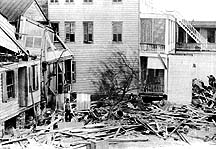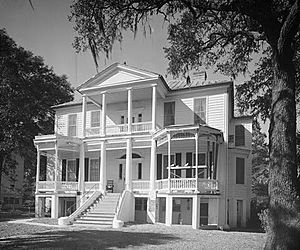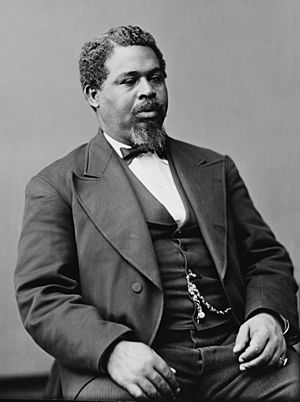History of Beaufort, South Carolina facts for kids
The history of Beaufort, South Carolina, is really interesting! It's one of the oldest and most diverse towns of its size in the United States.
Contents
Beaufort's Story: An Overview
This area was explored by many Europeans, and some tried to start colonies here. Scottish settlers created "Stuart Town" in 1684, but it didn't last long. The British successfully founded Beaufort in 1711. It's the second-oldest city in South Carolina, after Charleston.
The city grew slowly at first because of attacks from Native Americans. Later, it became a busy center for the Lowcountry plantation economy. This lasted until the Civil War. In the late 1900s, Beaufort bounced back. Today, it's known as one of the best small towns to live in. Beaufort has kept its historic feel thanks to its beautiful old buildings and efforts to protect its history.
Colonial Times: 1711–1783
Beaufort's written history began about 500 years ago. Spanish Captain Pedro de Salazar explored the area between 1514 and 1516. This means Beaufort County was one of the first places in North America where Europeans landed. Ponce de Leon landed near St. Augustine, Florida just a year or so earlier in 1513.
Beaufort was officially started in 1711. It was the second main settlement in South Carolina. The city was named after Henry Somerset, 2nd Duke of Beaufort. It grew very slowly at first. This was because of a big attack by the Yemassee people in 1717. There was also a threat of invasion from Spain.
Beaufort really started to grow in 1733. This was when Georgia was founded as a buffer colony, protecting South Carolina. Most of the early colony's power was in Charleston. But Beaufort became known for its great harbor. It also had several churches, like St. Helena's Episcopal. By 1776, the city was famous for shipbuilding. It also traded a lot of rice and indigo. A new circuit court was set up there for the colony.
The American Revolution divided people's loyalties in Beaufort. Some families supported the British (called Tories). Others wanted independence. Many men from Beaufort fought in battles elsewhere in the state. Not much fighting happened right in Beaufort. In January 1779, British forces tried to take Port Royal Island. But they were stopped by militia led by William Moultrie in the Battle of Beaufort. The British did occupy the area later in 1779. However, they left when Savannah was attacked.
After 1780, British forces controlled most of coastal South Carolina. This was after the Siege of Charleston. After the American victory in the 1781 Siege of Yorktown, the British Army started leaving the Lowcountry in 1782. Unlike other places, almost all the Loyalists in Beaufort decided to stay. Important American patriots like Francis Marion and Thomas Sumter helped convince them. They promised that the Loyalists and their property would be safe in the new country. This worked, and very few Loyalists left Beaufort after the war. The Treaty of Beaufort was signed in the city in 1787. This treaty set the border between South Carolina and Georgia.
Wealth Before the Civil War: 1783–1861
In the years before the Civil War, growing "Carolina Gold" rice and Sea Island Cotton brought huge wealth to Beaufort. It also made the surrounding plantations very rich. Beaufort was one of the wealthiest cities in the United States before the Civil War. It was even called the "Newport" of the South.
While Charleston and Columbia were the biggest cities in the state, Beaufort had a lot of economic and political power. Planters in Beaufort and nearby islands strongly supported states' rights. They wanted states to have more power than the national government. This was seen during the Nullification Crisis in the 1830s and again in the 1850s.
Right before the Civil War, Beaufort was at its best. It had about 4,000 people, not counting enslaved people. Like today, many people from outside the state moved to Beaufort. Many Northerners and Europeans lived there and ran successful businesses.
Civil War and Rebuilding: 1861–1893
The Civil War changed Beaufort a lot. In November 1861, Union forces attacked and took over the city. This made Beaufort one of the first places in the Deep South held by the Union. Most of the town's buildings were saved. However, there was some burning and stealing.
A special effort called the Port Royal Experiment happened in Beaufort. This was before the main American Reconstruction. It was a test to see how formerly enslaved people (called freedmen) could be educated. Besides education, the city also made political progress. Robert Smalls, who was born in Beaufort, became a leading figure after the war. He was one of South Carolina's first African-Americans elected to the United States Congress. He remained an important leader in the state and in Beaufort until he passed away in 1915. Because of its large African-American population and Smalls's leadership, Beaufort remained a strong hold for the Republican Party in the Solid South.
Some of Beaufort's important families came back after the war. But they never got back the huge wealth that came from farming with enslaved labor. Most of the original powerful families never returned. As cotton farming became less important, mining for aqua phosphate grew. By 1890, Beaufort had regained some wealth from this industry. It also kept its role as the county seat. Before, it had lost this to the railroad town of Coosawhatchie. But then, a series of events led to Beaufort's economy declining for over 50 years.
Hard Times: 1893–1945

On August 27, 1893, a very strong Category 3 hurricane hit the Lowcountry. It killed over 2,000 people in the area and caused huge damage. Only four people died in Beaufort itself. But the city was badly damaged, and its phosphate industry was ruined. A fire in 1907 damaged much of the downtown area. This caused more economic and emotional harm.
A final blow was the gradual spread of the boll weevil. This insect destroyed most of the cotton crop. Cotton had been the main product of the community for over a century. By 1910, Beaufort had lost almost 40% of its population compared to ten years earlier. Even though it remained the county seat, Beaufort became one of the poorest communities in the state through the 1940s. During this time, growing lettuce and tomatoes, along with shrimping, became the main parts of the economy.
Beaufort's Comeback: 1945 – Present
Beaufort's economic recovery in the second half of the 20th century came from three main things. These were military investments, new resorts, and fixing up downtown.
Even though Parris Island was used by the military after the Civil War, it wasn't a major base until 1917. That's when it became the permanent home for the U.S. Marine Corps recruiting station. World War I, World War II, and especially the Cold War brought many new people and money to the area. A naval air station was built during World War II. It was given to the Marine Corps in the 1950s. This made the military a big part of the region's future. A U.S. Naval Hospital was also built in nearby Port Royal during the war.
New money came from building resorts and lifestyle communities. These were on nearby Hilton Head Island and Fripp Island. This helped Beaufort's economy starting in the 1960s. A big improvement happened when an old waterfront park was built downtown. It replaced old docks. Mayor Henry Chambers championed this project. The park, now named after Chambers, helped restart development and investment in Bay Street and downtown Beaufort. This made land values go up and attracted real estate investors, national media, and Hollywood. In recent years, the park has been updated. Many private homes and businesses have been renovated. Several street projects have also continued to make life better in Beaufort.
Unlike many towns its size in the South, Beaufort avoided much of the trouble during the Civil Rights Movement. Jim Crow laws were slowly removed during the 1960s. Schools began to integrate in 1964 and were fully integrated by 1970. Beaufort also elected its first African-American to the city council in 1967. The city has seen other changes in its population. This is partly because of the military presence. It's also a popular place for people from the northern United States and Canada to retire. There's also a need for migrant workers, mostly from Latin American nations, for seasonal farming.



